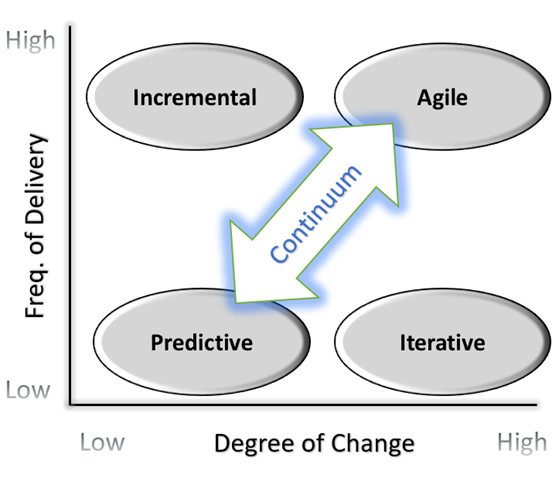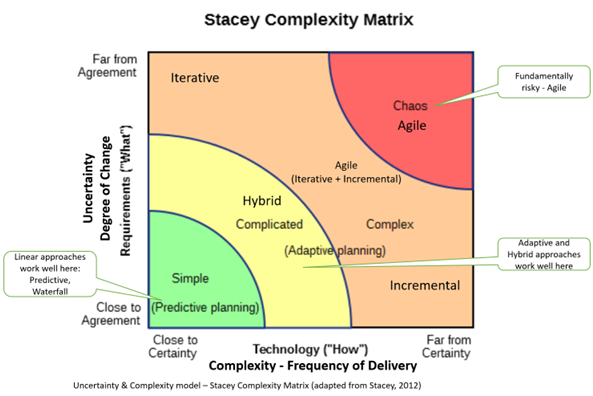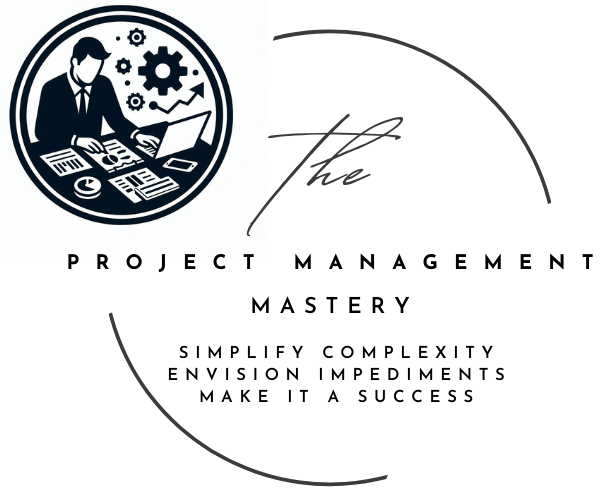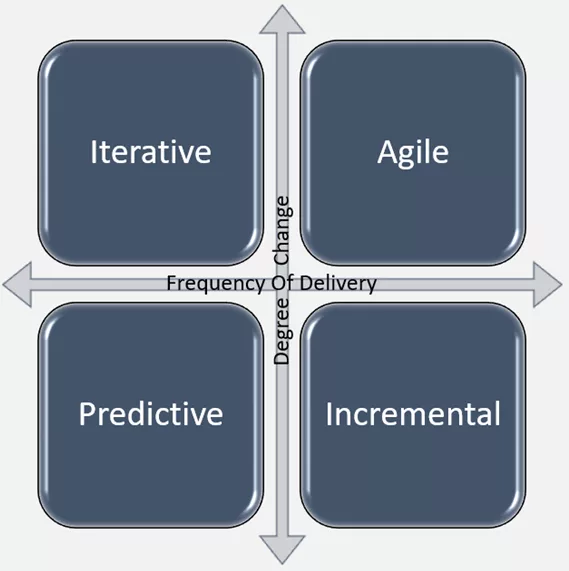Agility in project management isn’t a trend; it’s a vital strategy that aligns teams and processes for effective outcomes. I’m here to guide you through the nuances of agile project management as fostered by the Project Management Institute (PMI). PMI, in partnership with Agile Alliance®, crafted the Agile Practice Guide back in 2017 [Agile Practice Guide (2017)]. This guide serves as a beacon for project managers navigating the changing tides of business requirements and customer needs.
The guide emphasizes that while both predictive (traditional) and agile (adaptive) methodologies involve planning, the way it unfolds is noticeably different in each environment. Predictive planning is exhaustive and set well in advance, while agile planning is dynamic, allowing for continuous revisions and adjustments.
Understand that projects can be broadly categorized into two types of work:
- Definable Work: involving tasks with established procedures, lower uncertainty, and minimized risk – think of a car assembly line, where repetition and precision dominate.
- High-Uncertainty Work: it is akin to venturing into virgin waters; it’s exploratory and filled with complexity, demanding collaboration and creative problem-solving – imagine designing groundbreaking technology where innovation is key such as EV batteries where boundaries are continuously being pushed to innovate on safety, energy density, longevity, fast charging, and cost reduction.
It’s crucial to recognize that the ecosystem of agile project management is rooted in values and principles that foster effectiveness. Built upon these values and principles is the Agile Manifesto, which continues to serve as the foundation of agile methodologies across industries.
The Agile Manifesto: Transforming Values into Action
Back in 2001, a group of forward-thinking software developers gathered to discuss a new way of managing projects. What emerged was the Agile Manifesto, a document that revolutionized the field of software development and project management. This wasn’t just a set of rules; it was a declaration that put the spotlight on a more dynamic and people-focused approach to building software.
The essence of the Agile Manifesto is encapsulated in four fundamental values:
- First, it advocates for “individuals and interactions” over processes and tools. This value recognizes that the heart of any project is the people working on it, not just the systems they use. It’s about fostering collaboration and open communication.
- Second, the Manifesto emphasizes the importance of “working software” over comprehensive documentation. This is not to say documentation is irrelevant, but rather, the primary measure of progress is the delivery of functional software that meets users’ needs.
- Third, there’s an emphasis on “customer collaboration” over contract negotiation. Agile encourages teams to work closely with clients, involving them in the development process, and prioritizing their feedback to deliver a product that truly satisfies their requirements.
- Lastly, “responding to change” over following a plan underscores the agile belief in being adaptive and flexible. Instead of rigidly sticking to a set plan, the agile approach is to embrace changes, even late in the development process, to provide the best possible outcome.
These four values are supported by 12 underlying principles that guide teams towards early and continuous delivery of valuable software. These principles urge teams to welcome changes, release working products frequently, and collaborate closely with clients throughout the project’s life. It also encourages simplicity and sustainable development practices, aiming for a consistent pace and good project rhythm.
Bear in mind that these values and principles don’t exist in isolation. They form the foundation upon which the agile mindset is built—a mindset that is not confined to the pages of a manifesto but comes to life through a variety of practices, tailored to the unique demands of every project.
Cultivating the Agile Mindset and Implementing Agile Practices
Embracing an agile mindset is the cornerstone of effective project management within the realm of Agile. It is a comprehensive frame of thought guided by values and principles aimed at enhancing collaboration, adaptability, and customer satisfaction. Agile is about creating a culture that promotes accountability, fosters innovation, and endorses a flexible approach to problem-solving.
The journey towards agile practices began well before the term ‘Agile’ was coined by the manifesto in 2001. Techniques that are central to Agile today were being used but were disparate and lacked a unified direction. The Agile Manifesto served as a landmark event, unifying and formalizing these practices under the umbrella of Agile methodology. Key techniques include sprints, stand-ups, and retrospectives that collectively drive the project forward. You will encounter as well other approaches within the realm of Agile such as:
- Scrum
- eXtreme Programming (XP)
- Kanban method
- Crystal methods
- Scrumban
- Feature-Driven Development (FDD)
- Dynamic Systems Development Method (DSDM)
- AgileUP
- Scrum of Scrums (SoS)
- Scaled Agile Framework (SAFe®)
- Large Scale Scrum (LeSS)
- Enterprise Scrum, and
- Disciplined Agile (DA).
It’s important to note that Agile and Kanban are not isolated concepts but are intertwined as aspects of Lean thinking. Both prioritize efficiency but approach it from slightly different angles. Agile focuses on the iterative development of software products, while Kanban emphasizes continuous flow and efficiency through workload management and visibility.
In the strategic application of these practices, there is no one-size-fits-all approach. Agile methods must be tailored to address the unique demands of each project. This might mean modifying or combining Agile and Kanban principles to better align with the project’s objectives. It’s about choosing the right tools and strategies to support the project’s needs, thus enabling teams to remain alert and responsive to change.
Navigating Project Life Cycles and Managing Uncertainty
Project management is akin to navigating a ship through the unpredictable waters of the business world. It requires understanding the various types of project life cycles and selecting the one most suited to the project at hand. The life cycles range from predictive to agile, each with a unique strategy for dealing with uncertainties, risks, and complexities especially when it comes to requirements or Degree of Change and technical uncertainties or Frequency of Delivery.
 First, consider the predictive life cycle, often characterized by in-depth planning and sequential execution. It’s a go-to option when dealing with projects that boast clear requirements and lower technical uncertainties or risk levels. Its structured nature means surprises are few, but flexibility is also limited.
First, consider the predictive life cycle, often characterized by in-depth planning and sequential execution. It’s a go-to option when dealing with projects that boast clear requirements and lower technical uncertainties or risk levels. Its structured nature means surprises are few, but flexibility is also limited.
Stepping into the realm of adaptive life cycles, we encounter iterative and incremental models. Iterative approaches thrive on feedback and refinement, allowing continual improvements with successive prototypes. Meanwhile, incremental life cycles shine by delivering usable portions of a project at regular intervals, thereby providing tangible results early and often.
The agile life cycle stands out by seamlessly amalgamating iterative and incremental methods. It’s known for its focus on frequent delivery and flexibility in response to change. An agile project is a pulsating hub of collaboration where adaptability is key, and customer involvement is constant.
Often, a project may not fit neatly into a single life cycle model. Here, a hybrid approach becomes invaluable. By combining elements of predictive and adaptive life cycles, hybrid models cater to projects that have clear components, yet also benefit from the adaptability of agile methods. Think of it as a continuum.
 Complexity resulting in frequency of delivery and uncertainty resulting in the degree of change are inherent to project work, and the agile methodology addresses these head-on. High-uncertainty and complexity projects, in particular, benefit from an agile approach. Here, embracing an iterative and incremental framework allows for risk to be managed more effectively. By frequently reviewing progress and adapting as needed, teams can reduce rework and ensure they’re always steering toward the most value-additive results.
Complexity resulting in frequency of delivery and uncertainty resulting in the degree of change are inherent to project work, and the agile methodology addresses these head-on. High-uncertainty and complexity projects, in particular, benefit from an agile approach. Here, embracing an iterative and incremental framework allows for risk to be managed more effectively. By frequently reviewing progress and adapting as needed, teams can reduce rework and ensure they’re always steering toward the most value-additive results.
In contrast, a project with consistent requirements and low complexity might align better with a predictive life cycle. However, when change is constant and complexity high, an incremental approach might be better suited to manage these dynamics with high frequency of delivery. Conversely, when requirements i.e. the ‘What’ or the Scope are far from being agreed upon at the start of the project (high degree of change due to uncertainty), but the technical challenges are known and controllable to make a single deliverable, an iterative approach might be adopted.
The best way to digest this nuance of the adaptive approaches would be in the following reinterpretation of Stacey complexity matrix:
 Understanding these facets ensures that the process of determining which life cycle to employ is never taken lightly. It’s a deliberate choice that can make or break a project’s success.
Understanding these facets ensures that the process of determining which life cycle to employ is never taken lightly. It’s a deliberate choice that can make or break a project’s success.
Integrating and Transitioning to Agile Practices for Optimal Outcomes
When I reflect on the vast landscape of project management methodologies, the paramount goal that towers over the rest is the relentless pursuit of delivering continuous value to customers. Being agile isn’t merely a badge to wear with honor – it’s a dynamic means to an end, and that end is customer satisfaction and project success.
In the realms of software development and beyond, it’s quite usual for teams to blend varying agile practices, cherry-picking elements from frameworks like Scrum, Kanban, and XP to perfectly tailor to the unique demands of their projects. This crafted cocktail of methodologies can lead to more cohesiveness within the team, fostering an environment conducive to innovation and high performance.
A gradual transition to agile methods tends to be the most effective way for an organization to reshape its processes. It’s not just about introducing new practices; it’s about nurturing a culture that embraces change, focuses on continuous learning, and prioritizes delivering value incrementally and iteratively or in a hybrid approach. Leveraging iterative techniques is a powerful way to facilitate learning and ensure that teams are in sync, while incremental approaches help in demonstrating early value to stakeholders, solidifying their buy-in.
Selecting the most fitting agile life cycle for a given project requires a thoughtful assessment of several pivotal elements. You must weigh factors such as requirement stability, complexity levels, and feedback necessity. Occasionally, the answer lies in a hybridized approach that harmonizes the predictability of traditional methods with the flexibility of agile philosophies. Be pragmatic in selecting your adaptive approaches and embrace the Hybrid approach with open arms.
So, when it’s time to steer a project across the rough waters of today’s business landscape, remember that agile is more than a methodology – it’s a beacon that guides you to adaptability, resilience, and, most importantly, an unyielding commitment to delivering value. The true essence of effective project management is recognizing that each project is distinctive, and the genuine skill lies in choosing and adapting the life cycle approach that aligns most closely with the project’s needs, inherent risks, and the culture of your organization.

